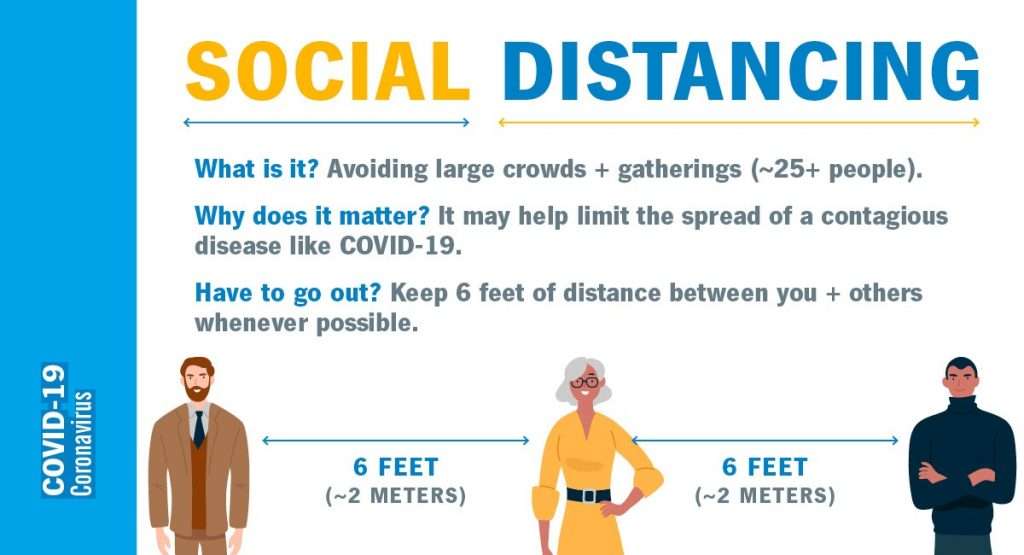Social Distancing(सामाजिक दुरी), Quarantine(क्वारेन्टिन), and Isolation(इसोलेशन)
Keep Your Distance to Slow the SpreadOther Languages
Limiting face-to-face contact with others is the best way to reduce the spread of coronavirus disease 2019 (COVID-19).
What is social distancing?
Social distancing, also called “physical distancing,” means keeping space between yourself and other people outside of your home. To practice social or physical distancing:
- Stay at least 6 feet (2 meters) from other people
- Do not gather in groups
- Stay out of crowded places and avoid mass gatherings
In addition to everyday steps to prevent COVID-19, keeping space between you and others is one of the best tools we have to avoid being exposed to this virus and slowing its spread locally and across the country and world.
When COVID-19 is spreading in your area, everyone should limit close contact with individuals outside your household in indoor and outdoor spaces. Since people can spread the virus before they know they are sick, it is important to stay away from others when possible, even if you have no symptoms. Social distancing is especially important for people who are at higher risk of getting very sick.
Why practice social distancing?
COVID-19 spreads mainly among people who are in close contact (within about 6 feet) for a prolonged period. Spread happens when an infected person coughs, sneezes, or talks, and droplets from their mouth or nose are launched into the air and land in the mouths or noses of people nearby. The droplets can also be inhaled into the lungs. Recent studies indicate that people who are infected but do not have symptoms likely also play a role in the spread of COVID-19.
It may be possible that a person can get COVID-19 by touching a surface or object that has the virus on it and then touching their own mouth, nose, or eyes. However, this is not thought to be the main way the virus spreads. COVID-19 can live for hours or days on a surface, depending on factors such as sun light and humidity. Social distancing helps limit contact with infected people and contaminated surfaces.
Although the risk of severe illness may be different for everyone, anyone can get and spread COVID-19. Everyone has a role to play in slowing the spread and protecting themselves, their family, and their community.
Tips for social distancing
- Follow guidance from authorities where you live.
- If you need to shop for food or medicine at the grocery store or pharmacy, stay at least 6 feet away from others.
- Use mail-order for medications, if possible.
- Consider a grocery delivery service.
- Cover your mouth and nose with a cloth face cover when around others, including when you have to go out in public, for example to the grocery store.
- Stay at least 6 feet between yourself and others, even when you wear a face covering.
- Avoid large and small gatherings in private places and public spaces, such a friend’s house, parks, restaurants, shops, or any other place. This advice applies to people of any age, including teens and younger adults. Children should not have in-person playdates while school is out. To help maintain social connections while social distancing, learn tips to keep children healthy while school’s out.
- Work from home when possible.
- If possible, avoid using any kind of public transportation, ridesharing, or taxis.
- If you are a student or parent, talk to your school about options for digital/distance learning.
Stay connected while staying away. It is very important to stay in touch with friends and family that don’t live in your home. Call, video chat, or stay connected using social media. Everyone reacts differently to stressful situations and having to socially distance yourself from someone you love can be difficult.
What is the difference between quarantine and isolation?
Quarantine
Quarantine is used to keep someone who might have been exposed to COVID-19 away from others. Someone in self-quarantine stays separated from others, and they limit movement outside of their home or current place. A person may have been exposed to the virus without knowing it (for example, when traveling or out in the community), or they could have the virus without feeling symptoms. Quarantine helps limit further spread of COVID-19.
Isolation
Isolation is used to separate sick people from healthy people. People who are in isolation should stay home. In the home, anyone sick should separate themselves from others by staying in a specific “sick” bedroom or space and using a different bathroom (if possible).
What should I do if I might have been exposed? If I feel sick? Or have confirmed COVID-19?
If you think you have been exposed to COVID-19, find symptoms,
If you…
Steps to take…
If you or someone in your home might have been exposed
Self-Monitor
Be alert for symptoms. Watch for fever,* cough, or shortness of breath.
- Take your temperature if symptoms develop.
- Practice social distancing. Maintain 6 feet of distance from others, and stay out of crowded places.
- Follow authorized health care taker advice if symptoms develop.
If you feel healthy but:
- Recently had close contact with a person with COVID-19, or
- Recently traveled from somewhere outside the U.S. or on a cruise ship or river boat
Self-Quarantine
- Check your temperature twice a day and watch for symptoms.
- Stay home for 14 days and self-monitor.
- If possible, stay away from people who are high risk for getting very sick from COVID-19.
If you:
- Have been diagnosed with COVID-19, or
- Are waiting for test results, or
- Have symptoms such as cough, fever, or shortness of breath
Self-Isolate
- Stay in a specific “sick room” or area and away from other people. If possible, use a separate bathroom.
- Read important information about caring for yourself or someone else who is sick.


